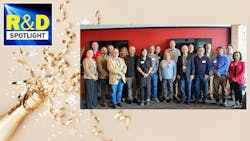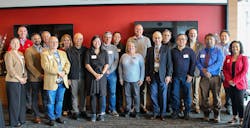R&D Spotlight: Inventors Celebrate Ingenuity at Patent Medallion Luncheon
Twenty inventors from the College of Engineering at the University of Arizona were recognized for their part in bringing the university to its second year as No. 28 in the world among universities granted U.S. utility patents.
Among the honorees at a Patent Medallion Luncheon in March, was Hao Xin, a professor of electrical and computer engineering and physics. Xin, along with fellow electrical and computer engineering instructors Siyang Cao and Min Liang, are using radar to make breakthroughs in driverless technology.
Also present was Judith Su, an assistant professor of optical sciences and biomedical engineering, who has developed a technique known as FLOWER, or Frequency Locked Optical Whispering Evanescent Resonator, which allows for the diagnosis of a variety of diseases at their earliest stages.
“The diversity of these inventions demonstrates the many ways our Arizona engineers are serving humanity and advancing knowledge,” said David W. Hahn, the Craig M. Berge Dean of the College of Engineering. “I’m honored to recognize this group of innovators for their commitment to excellence, in collaboration with our partners at Tech Launch Arizona.”
Technology Transfer
Ordinarily, scientists would turn to peer-reviewed publications for idea validation. In this case, the engineering recipients of medallions can thank technology transfer, a process for patenting discoveries and licensing them to businesses that can turn them into life-saving commercial products.
Researchers who choose the patenting route can credit a pair of senators, Birch Bayh (Indiana) and Bob Dole (Kansas), for the control they have over their inventions’ IP in order to market or commercialize their inventions. In 1980, the namesakes behind the Bayh-Dole Act, or Patent and Trademark Law Amendment Act, revolutionized technology transfer by allowing universities, non-profits and small businesses to turn their discoveries into viable products.
Before the law was enacted, billions of dollars’ worth of federally funded research went unused, as the universities and others funded by agency support were stripped of their patent rights.
The Bayh-Dole Coalition’s website notes a long list of innovations made possible by the Act, including the Ebola vaccine (Ervebo or rVSV-ZEBOV), quantum computing, magnetic resonance spectroscopy, neoprene and advanced ultrasound imaging.
Across the U.S., economic development initiatives and start-up accelerators (such as Y Combinator, TechStars and DreamItVentures) harness technology transfer to license research innovations. Others explore technical potential through Small Business Innovation Research (SBIR) and Small Business Technology Transfer (STTR) programs to help convert research from lab to market.
Patent Inventors
Early-stage inventions, such as those from the University of Arizona, stand to benefit from the protection of a successful patent system, since no competitors can use their discoveries for a certain period of time.
The University of Arizona noted that, of all the university patents in the most recent fiscal year, 20% were issued to engineering faculty and their collaborators.
The following University of Arizona faculty members, graduate students and alumni received medallions.
Aerospace and Mechanical Engineering
Linan Jiang – Micro-Scale Concentrated Photovoltaic Module and Polymer Waveguide Interconnect Between Chips
Peiwen Li – High Temperature Fuel Cell System
Jekan Thanga – Laser Position Control and Space Traffic Management
Biomedical Engineering
Carissa Grijalva (graduate student) – Active Assist Orthotic
Minkyu Kim – Antimicrobial Biopolymers for Microbial Infections
Marek Romanowski – Ocular Cranial Nerve Monitoring System
Marvin Slepian – Determining Overall Motion and Flexibility Envelope; Systems and Methods for Characterizing Sepsis; and System for Monitoring Therapeutic Procedures
Tsu-Te Judith Su – Photonic Apparatus, Methods, and Applications
Chemical and Environmental Engineering
Gregory Ogden and Kimberly Ogden – Optical Device for Monitoring of Microorganisms
Electrical and Computer Engineering
Siyang Cao, Min Liang (alum) and Hao Xin – Automotive Radar Using 3D Printed Luneburg Lens
Wolfgang Fink – Vehicular Tip or Rollover Protection Mechanisms and Traverse Optimization and Multi-Purpose Tracking
Min Liang (alum) and Hao Xin – Hollow Light Weight Lens Structure
Mining and Geological Engineering
Jinhong Zhang – Material with Improved Strength/Water Resistance
Materials Science and Engineering
Pierre Deymier – Tunable of Quantum-like Mechanical Elastic Systems
Douglas Loy – Dihydropyridazine Antioxidant Sunscreens and Forming a Network Foam Using Diels-Alder Reactions
Optical Sciences and Engineering
Chaohan Cui (graduate student) – Quantum Receiver Method Decoding an Optical Signal
About the Author

Rehana Begg
Editor-in-Chief, Machine Design
As Machine Design’s content lead, Rehana Begg is tasked with elevating the voice of the design and multi-disciplinary engineer in the face of digital transformation and engineering innovation. Begg has more than 24 years of editorial experience and has spent the past decade in the trenches of industrial manufacturing, focusing on new technologies, manufacturing innovation and business. Her B2B career has taken her from corporate boardrooms to plant floors and underground mining stopes, covering everything from automation & IIoT, robotics, mechanical design and additive manufacturing to plant operations, maintenance, reliability and continuous improvement. Begg holds an MBA, a Master of Journalism degree, and a BA (Hons.) in Political Science. She is committed to lifelong learning and feeds her passion for innovation in publishing, transparent science and clear communication by attending relevant conferences and seminars/workshops.
Follow Rehana Begg via the following social media handles:
X: @rehanabegg
LinkedIn: @rehanabegg and @MachineDesign

